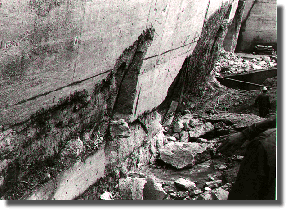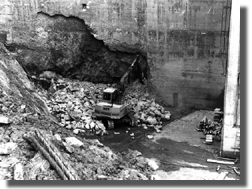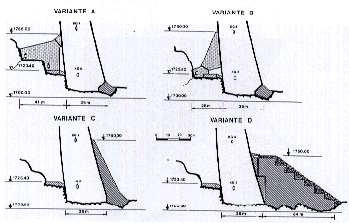Kolnbrein Problem
|
- During the first partial filling, the structure acted normally, although
some cracking was noticed on the upstream side. After the second partial
filling in 1979, uplift and seepage were noticed. The cracking was letting
water bypass the grout curtain and seep under the dam, creating the uplift pressure.
- Engineers tried to increase the drainage to fix these problems, but this
was not enough.
- By analyzing the dam monitoring data, the engineers deduced that the
cracking was due to uplift pressure and leaking. The crack was grouted.
|

The actual crack in the Kolnbrein dam
Click to see enlarged image
photo courtesy of Linsbauer |
- A panel of dam safety experts was called together to work with the
Tauwerkraft team. The panel lowered the permissible maximum water level while
still allowing the dam to produce power for the country.
- Additional remedies were required for the cracking. The crack needed to
be grouted with an elastic material, one that would allow for movement of the
dam. A rigid grout would have kept the dam from expanding and contracting.
|
- The engineers thus froze the area around the crack during reservoir
filling to close the crack. During drawdown, the ice was thawed, allowing for
the necessary expansion of the dam.
- A more permanent solution was needed. A new concrete apron was
constructed across the upstream face of the dam. An elastic joint connected
the two.
|

Digging out the crack
Click to see enlarged image
photo courtesy of Linsbauer |
- The reservoir was filled again in 1983. A new crack was discovered on the
upstream side.
- In 1989, engineers decided to construct a support on the downstream side of
the dam. They looked at several different configurations for the support,
called a buttress. Several iterations were required to determine the best way
to attach the buttress to the arch.

- The repairs to the dam totalled $190 million.
|


|


